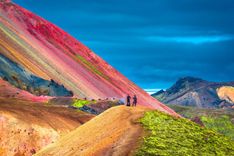5. See Seljalandsfoss, Skógafoss, and Dettifoss
Each of these waterfalls feels different. At Seljalandsfoss, there’s a path that lets you walk behind the 200-foot (60-meter) curtain of water—just expect to get wet. Skógafoss is also about 200 feet (60 meters) high but much wider and louder, and you can climb the staircase next to it for a view from above. It’s also where the Fimmvörðuháls hiking trail begins. Dettifoss, in the north, is shorter at around 144 feet (44 meters), but the volume and power of the water are intense.
In summer, the roads are clearer, and the longer days mean you can visit more than one in a single trip without feeling rushed. You’ll also avoid the icy paths that make some areas tricky in winter.
How to get to the waterfalls
How to plan a trip to Iceland to see the most of the country's waterfalls? Seljalandsfoss and Skógafoss are both easy to reach from Route 1 on the South Coast—about a 2- to 3-hour drive from Reykjavík. Dettifoss is farther north and takes more planning. You can get there via Route 862 or 864, but it adds a few hours to your drive. All three waterfalls have parking nearby and marked trails. If you're planning to walk behind Seljalandsfoss, bring a rain jacket—you’ll definitely get sprayed.
6. Explore Reykjavík
Reykjavík is small, easy to walk, and full of personality. In summer, the city feels more active—people are out late, restaurants and cafés are busy, and there are often events or live music. Since it stays light for most of the night, you can take your time exploring without checking your watch.
Downtown has a mix of old and new—colorful houses, modern architecture, small galleries, and good places to eat. You can visit the Hallgrímskirkja church for views over the city, walk along the harbor, or stop by Harpa Concert Hall to check out the design. There are also museums focused on Viking history, art, and local culture.
The city is also known for its culinary scene: see our guide to the best restaurants in Reykjavik.
How to get to Reykjavík
It takes about 45 minutes to get from Keflavík Airport to Reykjavík by Flybus or rental car on Route 41. Once you’re in the city, most things are within walking distance.
Public buses connect to nearby areas and to places like the Blue Lagoon. Parking downtown can be pricey and limited, so if you’re staying overnight, it’s worth checking if your hotel has a better option. If nightlife is on your list, it’s easier to stay somewhere central so you can walk home. See our guide to spending 3 days in Reykjavik.
















